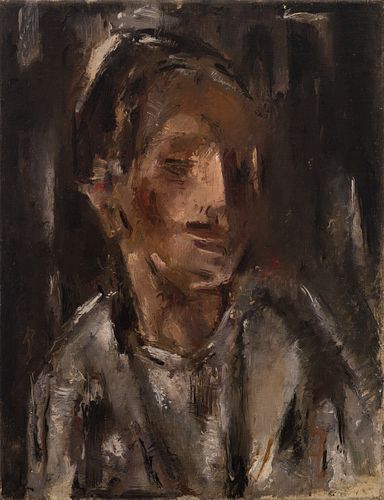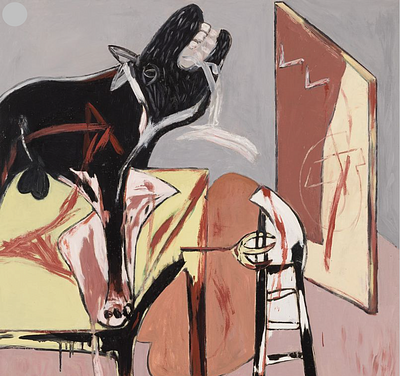MARÍA GUTIÉRREZ BLANCHARD (Santander 1881 - Paris 1932). "Woman's head", 1932. Oil on canvas.
Lot 88
About Seller
Setdart Auction House
Carrer Aragó 346
Barcelona
Spain
Setdart Subastas was born in 2004 and is currently the first online art auction in Spain with solidity, prestige and reliability guaranteed by our more than 60,000 users. Setdart has a young, dynamic and enterprising team ready to successfully manage the purchase and sale of art works through custom...Read more
Estimate:
EUR€60,000 - EUR€70,000
$64,516.13 - $75,268.82
Absentee vs Live bid
Two ways to bid:
- Leave a max absentee bid and the platform will bid on your behalf up to your maximum bid during the live auction.
- Bid live during the auction and your bids will be submitted real-time to the auctioneer.
Bid Increments
| Price | Bid Increment |
|---|---|
| EUR€0 | EUR€10 |
| EUR€200 | EUR€25 |
| EUR€500 | EUR€50 |
| EUR€1,000 | EUR€100 |
| EUR€3,000 | EUR€200 |
| EUR€5,000 | EUR€500 |
| EUR€10,000 | EUR€1,000 |
| EUR€20,000 | EUR€2,000 |
| EUR€50,000 | EUR€5,000 |
About Auction
By Setdart Auction House
Nov 16, 2021
Set Reminder
2021-11-16 08:00:00
2021-11-16 08:00:00
America/New_York
Bidsquare
Bidsquare : Contemporary and Actual Art
https://www.bidsquare.com/auctions/setdart-auction-house/contemporary-and-actual-art-7839
Setdart Auction House sofia@setdart.com
Setdart Auction House sofia@setdart.com
- Lot Description
MARÍA GUTIÉRREZ BLANCHARD (Santander 1881 - Paris 1932). "Woman's head", 1932. Oil on canvas. Work reproduced in the catalog raisonné of the artist, p. 660- 661 nº 309. Signed in the lower left corner (MB). Signed and dated on the back. Measurements: 60 x 50 cm; 62 x 52 cm (frame). In this portrait made in the last year of the artist's life, the author presents us with a work in which she unites and harmonizes all the plastic experiences that were part of her artistic trajectory. For this reason Blanchard conceives a portrait of cubist heritage, an influence that can be seen in the chromatic range based on ochers and grays, and in the treatment of the background, which seems to pounce on the figure, totally reducing the spatiality. However, Blanchard does not abandon realism, but forms a portrait of recognizable forms, heir to the portrait tradition and also brings a mature vision, typical of his last stage, defined through the use of a broad, fast and vibrant brushstroke, thus obtaining a work that stands out for its expressionist aesthetic. María Gutierrez Blanchard, usually known by her mother's surname, trained as a painter in Madrid, where she moved in 1903. Here she studied under the guidance of the painters Emilio Sala and Álvarez de Sotomayor. In 1909 she obtained a scholarship from the Diputación de Santander to study in Paris. In the French capital he received classes from Anglada Camarasa and Kees van Dongen, freeing him from his academic training and introducing him fully into the world of avant-garde art. In 1914 he returned to Madrid and began to attend Ramón Gómez de la Serna's gatherings at the Pombo café, participating in the controversial exhibition "Pintores íntegros". After devoting himself temporarily to teaching in Salamanca, in 1916 he returned definitively to Paris. From that year until 1920 he developed a cubist stage in which figurative references never disappeared. He was part of the Parisian cubist group and became friends with some of its members, such as Juan Gris, Lipchitz and André Lhote. In the 1920s he exhibited in exhibitions organized in Paris and Belgium. Among the works of his first stage stands out "The Communicant", presented with great success at the Salon des Indépendants in 1921. Between 1920 and 1932 he returned to a type of figurative painting, although cubist from the compositional point of view, in which the light treatment generates cottony textures. In Spain there have been two anthologies dedicated to the painter, one at the Biosca Gallery in Madrid (1962) and the other at the former Spanish Museum of Contemporary Art (1982). Maria Blanchard was both a great painter and a theoretician, since she organized gatherings in her Paris apartment, where different artists, including Juan Gris, discussed painting and the new trends that were taking place at the time.
- Shipping Info
-
In-house shipping available. Please inquire at admin@setdart.com.
-
- Buyer's Premium



 EUR
EUR CAD
CAD AUD
AUD GBP
GBP MXN
MXN HKD
HKD CNY
CNY MYR
MYR SEK
SEK SGD
SGD CHF
CHF THB
THB


















